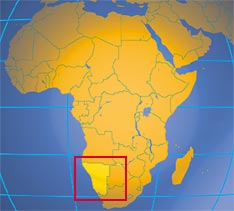Namibia’s installed power generation capacity of 498.5 MW, comprising 60% hydro and 40% thermal, is not enough to supply the country's demand of over 500 MW. NamPower, Namibia’s national power utility, is responsible for the generation, transmission and energy trading, which takes place within the Southern African Power Pool (SAPP), NamPower supplies bulk electricity to Regional Electricity Distributors (REDs), mines, farms and local authorities (where REDs are not operational) throughout Namibia.
Thermal
power stations
- Van Eck coal-fired power station is situated in the Northern Industrial area of Windhoek and has an installed capacity of 120 MW. As of 2015 only one block of 30 MW was active.
- Paratus diesel power station at Walvis Bay has an installed capacity of 24 MW.
- ANIXAS diesel power station at Walvisbay has an installed capacity of 22.5 MW
- In March 2015 Namibia’s power utility, NamPower, decided to award the tender for a 250 MW gas-fired power plant to Xaris Energy, which will be 30% owned by NamPower with other equity partners Xaris, Ariya Capital, General Electric and FGK Investments. Xaris and Ariya Capital Group formed a joint venture, Ariya Energy, which will advance the Walvis Bay project and develop other clean power projects in sub-Saharan Africa.
- NamPower is developing the 800 MW (nominal) Kudu Power Station through the KuduPower (Pty) Ltd, a Special Purpose Vehicle that was established in 2005. The Kudu Power Station will be located 25 km north of Oranjemund.The Kudu Power Station will be the first Combined Cycle Gas Turbine power station of this size in Southern Africa and is expected to be commissioned by end of 2017. This station will burn the natural gas from the Kudu gas field to produce electricity. The offshore gas field, discovered in 1974, is approximately 170 kilometres north-west of Oranjemund in the Orange sub-basin in 170 metres of water. BW Offshore, a leading global provider of floating production services to the oil and gas industry, has been selected as the preferred technical operator of the Kudu power station. BW Offshore will take the 31% equity vacated by British oil and gas company, Tullow, as well as finance the 25% left vacant by CIECO Namibia's departure from the Kudu project. Namcor will cover the remaining 44% through funding from government as outlined in its support package.
The project comprises of two elements: the Kudu gas field development and pipeline to shore, as well as the power plant based in Oranjemund. BW Offshore will provide the floating production system services, while Saipem, an Italian oil and gas industry contractor, has been selected as the preferred contractor for the provision of sub-sea engineering procurement installation commissioning services.
Hydroelectrical
power stations
Solar Power
- The Ruacana Power Station is a hydroelectric power plant near Ruacana in northwest Namibia, close to the Angolan border. Water for the power station is stored in a dam just above the Ruacana Falls along the Cunene River. Several dams upstream help regulate the Cunene River to help the power station operate more efficiently. The power station is located underground near the bottom of the falls and has an installed capacity of 330 MW.
- The Baynes Hydropower Project, situated along the Cunene River, 200 km downstream of Ruacana is one of the long term projects in the feasibility phase. The Baynes Project will take six years to complete and the capacity would be 600 MW which will be shared equally by Namibia and Angola.
Solar Power
- Arandis Power spent N$40 million to complete the full bankable feasibility study on the establishment of a 120 MW Hybrid solar project. The thermal plant consists of 120 MW generated by reciprocating diesel engines using Heavy Fuel Oil, with associated fuel storage and processing facilities. The renewable component comprises 20 MW of solar generation situated on the same site.
- The
4,5
MW Omburu Solar PV
plant
near
Onaruru
opened
in May 2015. Innosun
Energy Holdings
is the first independent power producer (IPP) to set up a
photovoltaic power plant in Namibia. Innosun was formed in 2008,
with Black Diamond Investment as a local shareholder. The power from
the plant will be sold to Nampower under an agreement to last 25
years.
- Namibia is considering installing a 150 MW utility from OCI Solar Power to augment the country's existing power production.


No comments:
Post a Comment